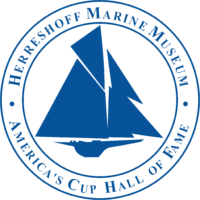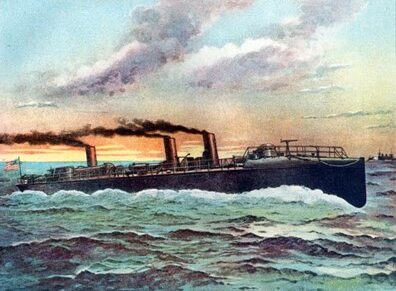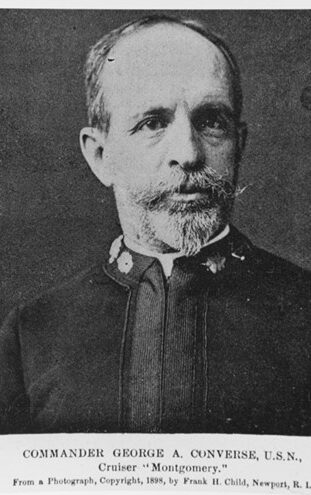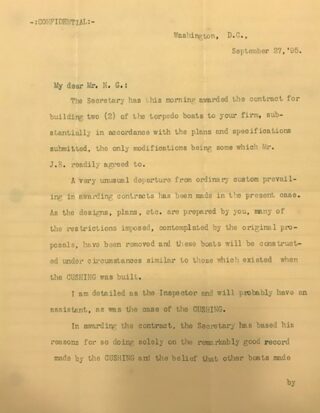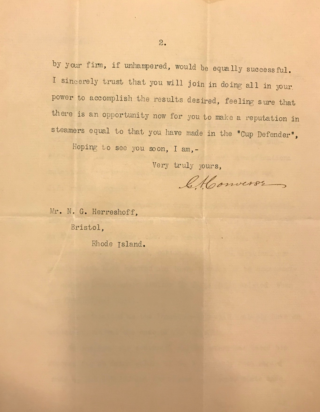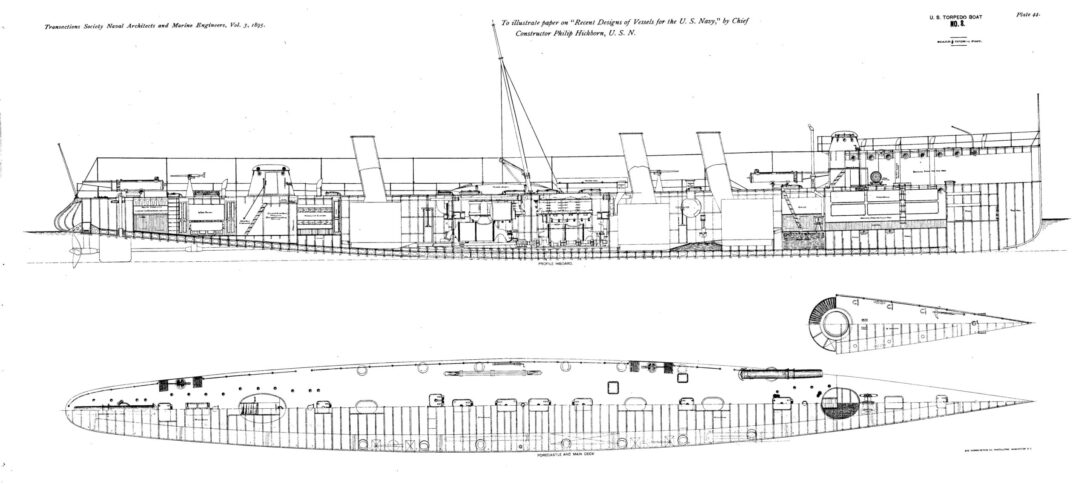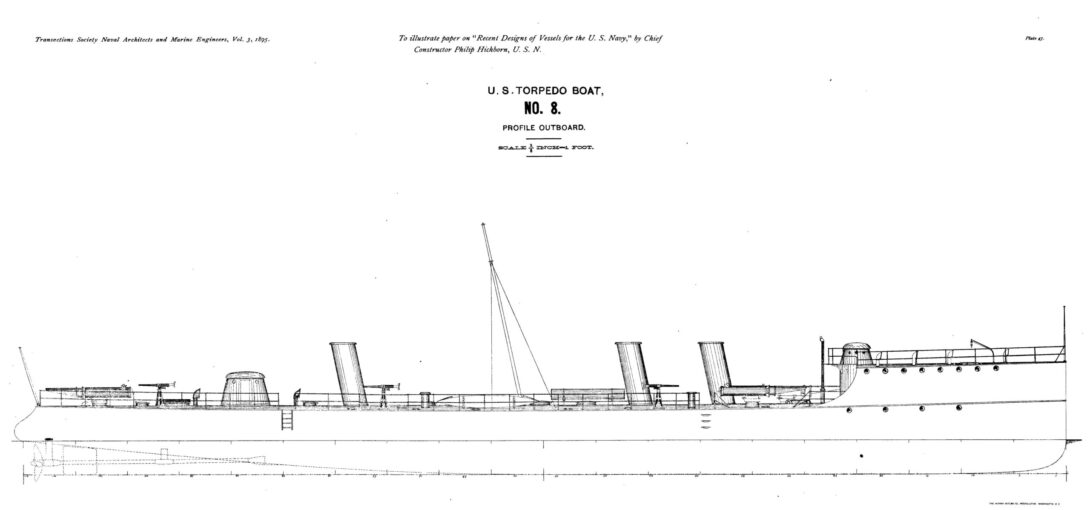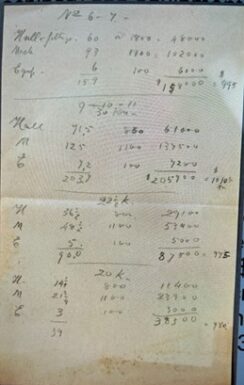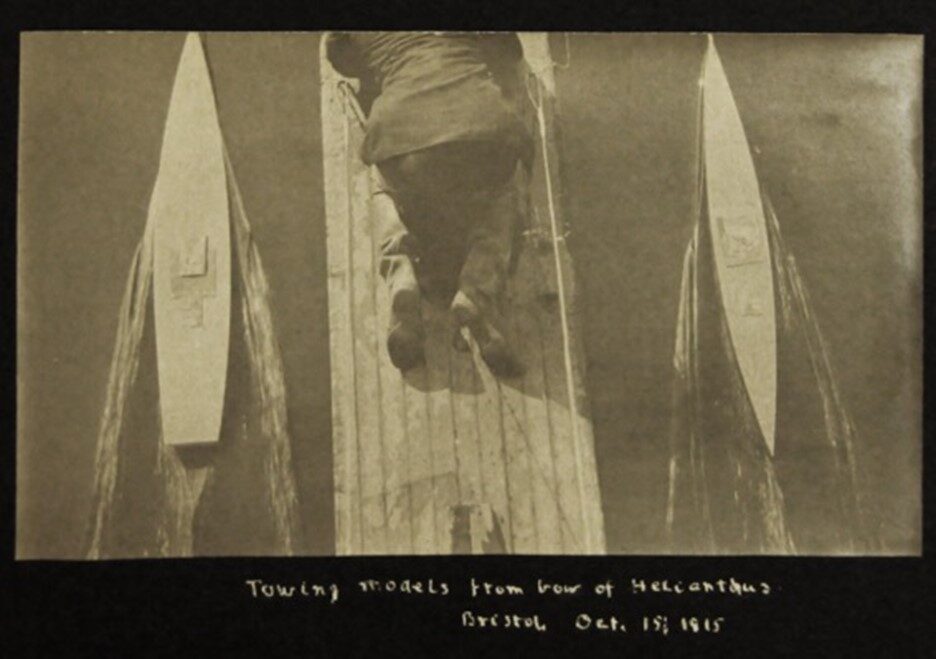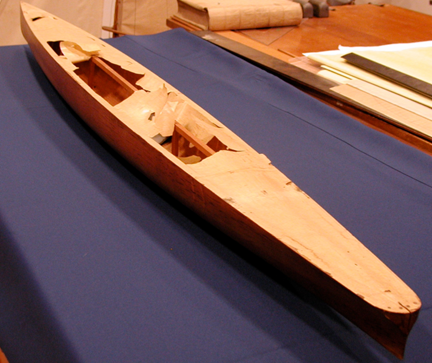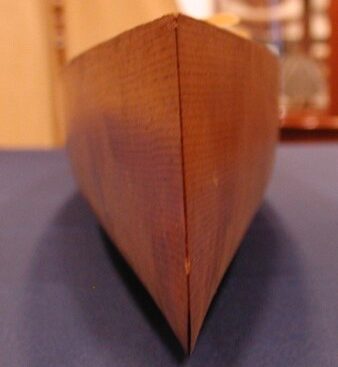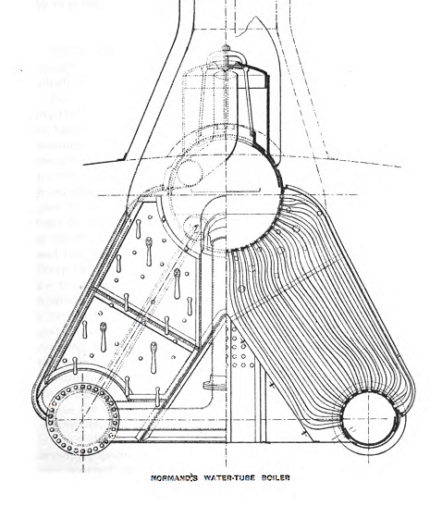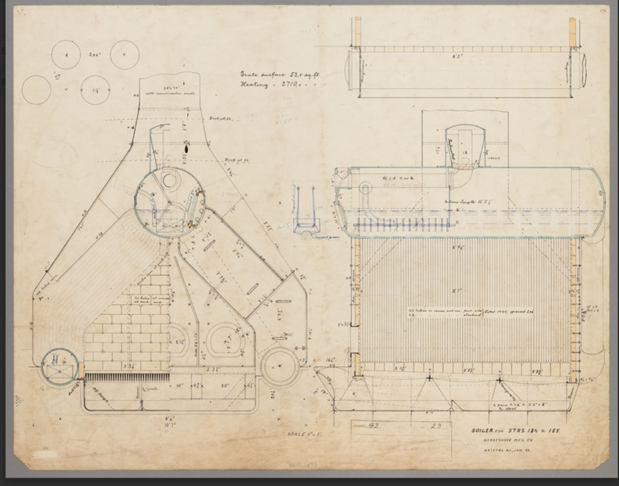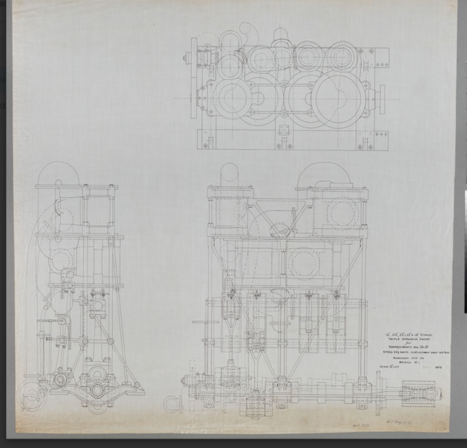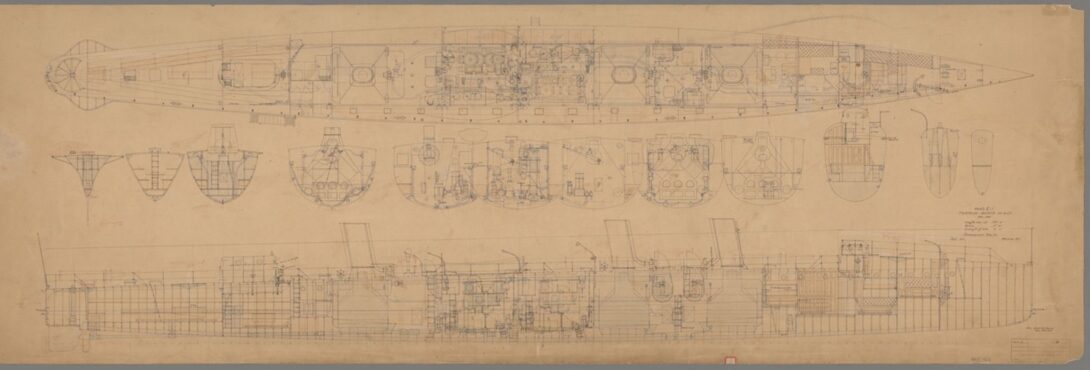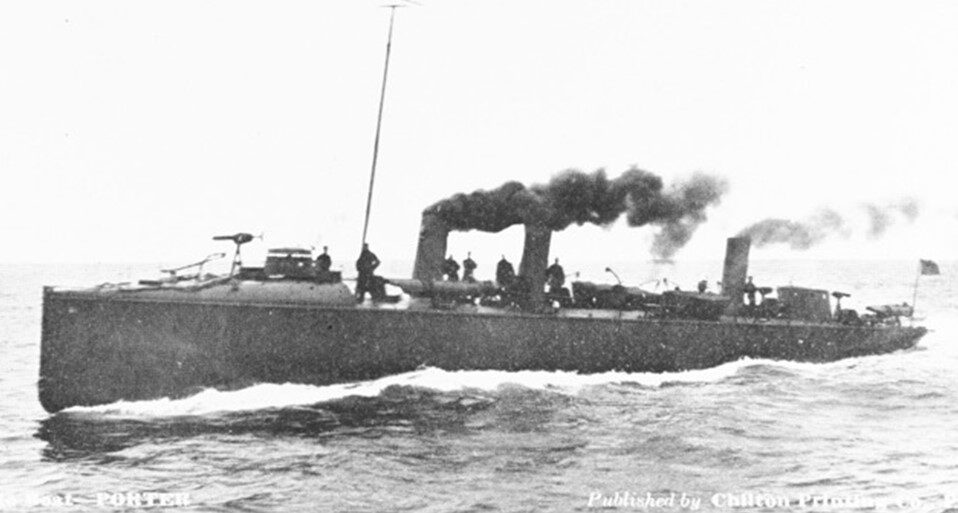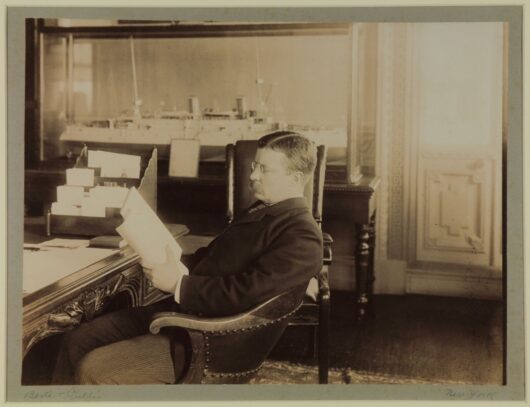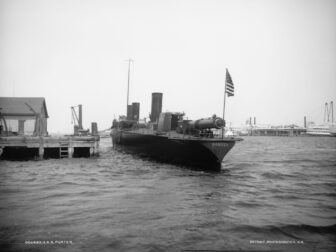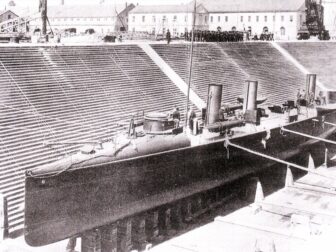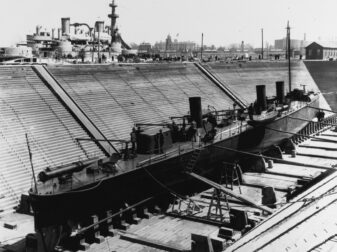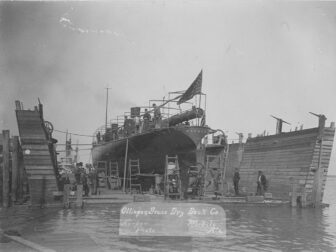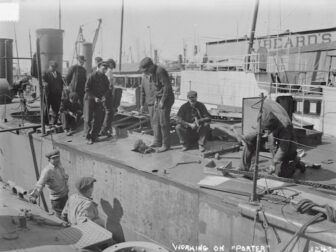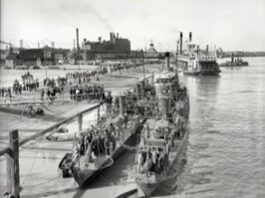July 17, 2023
The Herreshoff Brothers and their Torpedo Boats, Part X
A series of papers on bringing innovation to the "New Navy"
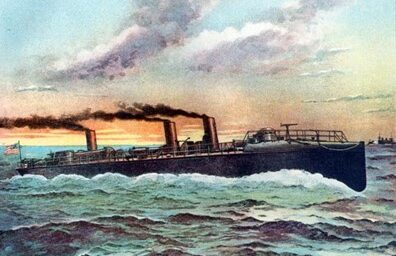
Success
Torpedo Boats 6 & 7 | 1895-1897
by John Palmieri
See on-line THE HERRESHOFF CATALOGUE RAISONNÉ for detailed information on HMCo. # vessels including photos, half model images and descriptive documents
Introduction
[1] citation
[1] Quotes from “Report of the Secretary of The Navy, William C. Whitney Dec. 1, 1886.” P.16. & “App. No. 3 Report of the Admiral of The Navy, David Dixon Porter. November 15, 1886.” P. 57. Annual Report of The Secretary of the Navy with Accompanying Documents for the Year 1886. Washington GPO 1886.
The brothers change strategy by entering into an initially confidential agreement with the Secretary of the Navy to build faster vessels, free from Bureau oversight. They deliver superior vessels, but in the process risk any future constructive relationship with the Bureaus.
[5] John R. Spears, The History of our Navy; from its origins to the End of the War with Spain (1775 – 1898); Vol V War with Spain, Charles Scribner’s Sons, New York 1902. Pg. 90. Also "Report of the Secretary of the Navy Dec. 6, 1887, William C. Whitney", Pgs. iii-iv.
[6] "The Building of Warships; Annual Report of Secretary Whitney; The Poor Results Attained by the New Cruisers (i.e., the ABC cruisers)- Broad Plans for Making the Navy Stronger", New York Times, Dec. 4, 1886.
[7] Sir Edward J. Reed, M.P. (late Chief Constructor of the British Navy) & Edward Simpson RADM USN (Late President US Naval Advisory Board), Modern Ships of War. (Harper & Brothers, New York, 1888) Pgs. 167-8. Provides specifics on John Roach actions to provide domestic steel plating for the ABCD ships.
[8] The purchase of quality domestic steel would remain a major problem for about 15 more years. Paul E. Pedisich, Congress Buys a Navy, Naval Institute Press, Annapolis MD. 2016. Pg. 62.
The Series will end with two more segments.
[5] John R. Spears, The History of our Navy; from its origins to the End of the War with Spain (1775 – 1898); Vol V War with Spain, Charles Scribner’s Sons, New York 1902. Pg. 90. Also "Report of the Secretary of the Navy Dec. 6, 1887, William C. Whitney", Pgs. iii-iv.
[6] "The Building of Warships; Annual Report of Secretary Whitney; The Poor Results Attained by the New Cruisers (i.e., the ABC cruisers)- Broad Plans for Making the Navy Stronger", New York Times, Dec. 4, 1886.
[7] Sir Edward J. Reed, M.P. (late Chief Constructor of the British Navy) & Edward Simpson RADM USN (Late President US Naval Advisory Board), Modern Ships of War. (Harper & Brothers, New York, 1888) Pgs. 167-8. Provides specifics on John Roach actions to provide domestic steel plating for the ABCD ships.
[8] The purchase of quality domestic steel would remain a major problem for about 15 more years. Paul E. Pedisich, Congress Buys a Navy, Naval Institute Press, Annapolis MD. 2016. Pg. 62.
● Part XI detailing the disastrous failure of Herreshoff to win a contract for a 30-knot TB. The success of TBs 14, 15 & 16; models of economy of construction and operation, followed by Herreshoff bidding failure and departure from the torpedo boat business.
● A Postscript addressing Capt. Nat’s brief reengagement with his US Navy torpedo boat supporters to provide the administration of President Theodore Roosevelt an improved class of destroyers.
Contracting for TBs 6, 7 & 8
[4] Thomas Wildenberg and Norman Polmar. Ship Killers: A History of the American Torpedo. (Annapolis, MD, USNI Press, 2010) pgs. 16-17.
Congress Authorizes Construction
[4] Thomas Wildenberg and Norman Polmar. Ship Killers: A History of the American Torpedo. (Annapolis, MD, USNI Press, 2010) pgs. 16-17.
On March 2, 1895, Congress approves construction of three torpedo boats at a unit cost not to exceed $175,000. Subtracting US Navy costs for superintending construction, preparing plans and specifications, procuring and installing Government furnished armament, the bid price is expected near $150,000. Congress restricts construction to one contractor each, on the Pacific Coast, the Mississippi River, and the Gulf of Mexico, unless the bids show they cannot be built at a fair cost, in which case the decision is left to the Secretary of the Navy.[1]
[40] Annual Report of The Secretary of the Navy November 28, 1881. Washington GPO 1881 Pgs. 3, 5, 6.
We use cookies to allow us to better understand how the site is used. By continuing to use this site, you consent to this policy. Click to learn more
US Navy Procurement Plan
[4] Thomas Wildenberg and Norman Polmar. Ship Killers: A History of the American Torpedo. (Annapolis, MD, USNI Press, 2010) pgs. 16-17.
Navy to Have Three Sea-Going Torpedo Boats
"With the Almost Incredible Speed of 26 Knots"
[1] citation
[1] Quotes from “Report of the Secretary of The Navy, William C. Whitney Dec. 1, 1886.” P.16. & “App. No. 3 Report of the Admiral of The Navy, David Dixon Porter. November 15, 1886.” P. 57. Annual Report of The Secretary of the Navy with Accompanying Documents for the Year 1886. Washington GPO 1886.
This is the lead sentence of the New York Times headline article of June 16, 1895, following release of the US Navy Department (Bureaus) plans and specifications. “Incredible” it is not!
[40] Annual Report of The Secretary of the Navy November 28, 1881. Washington GPO 1881 Pgs. 3, 5, 6.
We use cookies to allow us to better understand how the site is used. By continuing to use this site, you consent to this policy. Click to learn more
1. Beginning in early 1893 the British Admiralty started construction of 42 torpedo destroyers (TBDs) from different builders with differing boiler and engine designs. The first HAVOCK 180 ft LWL, 250 tons, 5000 ihp bult by Yarrow and equipped with locomotive style boilers, in trials bettered 26 knots. HORNET, a follow Yarrow TBD, but equipped with tubulous boilers, achieved 27.628 knots, and 27 knots becomes the speed objective for the program. At the same time a Normand built a 144 ft. French torpedo boat equipped with Du Temple type tubulous boilers also beat 27 knots in trials.[2]
2. It is a disappointment for Secretary Herbert. In April he had directed Chief BuC&R Hichborn to prepare plans for a torpedo boat of 180 tons, speed 27 knots.[3] Previous reports confirmed the Department at work to achieve 27 knots, planning for a vessel of 3500 horsepower, with three boilers, larger engines and increased coal bunker capacity. [4]
Through the summer there are numerous contacts between the Navy and potential bidders for the three torpedo boats. BuC&R inquires on the intentions of specific Pacific, Mississippi River, and Gulf of Mexico shipbuilders. Secretary Herbert makes clear his plan to appoint boards to investigate the yards ability to build the torpedo boats. Likewise, there are many Navy visits to the HMCo (often riding in HMCo-built torpedo boats STILETTO and CUSHING) where the Herreshoff brothers can make their case. Some are attracted by the new composite hull (aluminum, bronze, and steel) America’s Cup DEFENDER (HMCo 452). In early June the Chief BuOrd Commodore Sampson accompanied by CDR Converse in STILETTO, in late June the officers of the Naval War College transported in CUSHING and STILETTO, in July Naval Constructor Hobson to inspect DEFENDER, and in August, about one month before bid opening, Secretary Herbert accompanied by Sampson and Converse witness torpedo shoots by CUSHING and STILETTO. News account of the latter explicitly record Herreshoff’s case - Herreshoff will do for the Secretary what his Bureaus will not do; deliver a torpedo boat guaranteed to attain 27.5 knots. [5] [6] [7]
[40] Annual Report of The Secretary of the Navy November 28, 1881. Washington GPO 1881 Pgs. 3, 5, 6.
We use cookies to allow us to better understand how the site is used. By continuing to use this site, you consent to this policy. Click to learn more
And finally, to be sure there is no doubt regarding the Herreshoff offer, naval aide to the Secretary of the Navy, Benjamin Butler, at the request of Sampson, directs Converse to “find out if the two brothers are agreed on this proposition”, as he suggests they do not always agree.[8]
[40] Annual Report of The Secretary of the Navy November 28, 1881. Washington GPO 1881 Pgs. 3, 5, 6.
We use cookies to allow us to better understand how the site is used. By continuing to use this site, you consent to this policy. Click to learn more
The Bids and Bid Evaluation
[4] Thomas Wildenberg and Norman Polmar. Ship Killers: A History of the American Torpedo. (Annapolis, MD, USNI Press, 2010) pgs. 16-17.
(Bids see Table 1)
Bidder | Class 1 Bureau Plans & Specs | Class 2 Contractor Plans & Specs | Trial Speed Guaranteed for two hours |
|---|---|---|---|
Union Iron Works | San Francisco, CA
| 1 @ $175,000 2 f@ $173,000 each 3 f@ $172,000 each | 26 knots | |
Wolff & Zwicker Iron Works | Portland, OR | 1 @ $168,700 |
| 26 knots |
Moran Brothers | Seattle, WA | 1 @ $163,350 | 26 knots | |
Herreshoff Mfg. Co. | Bristol, RI |
| 1 @ $144,000 2 @ $144,000 each 3 @ $144,000 each | 27.5 knots (Signed contract includes $10K speed penalty if only reach 26.5 knots.) |
Table 1: Bids TBs 6, 7 & 8 Opened September 10, 1895 [9][10]
Chief Naval Constructor Hichborn and Engineer-in-Chief Melville are assigned by the Secretary to assess the bids. Their two-part 17-page report “Memorandum of objections to Herreshoff plans for Gunboats Nos. 6, 7, and 8”[11] , Hull written by BuC&R and Machinery by BuSteam, cites differences from the Bureau Class 1 plans; detailed objections, some of which are negotiated with John Brown Herreshoff in Wash. DC; and ends with conclusions and one recommendation.
[40] Annual Report of The Secretary of the Navy November 28, 1881. Washington GPO 1881 Pgs. 3, 5, 6.
We use cookies to allow us to better understand how the site is used. By continuing to use this site, you consent to this policy. Click to learn more
● Hull- Notes elimination of the forecastle deck, a bad arrangement of the boilers relative to the adjacent coal bunkers, a general slight reduction of scantlings, elimination of all galvanizing. It concludes many of the changes, “are in the line of cheapening the cost of the boat so that while the price of the bid is considerably lower than the lowest bid under Class 1, much of the difference is due to the fact that the Herreshoff boat is essentially a cheaper boat to construct.”
● Machinery- Objects to the proposed boilers, recommending a return to the Thornycroft used in CUSHING. (Herreshoff apparently, in the effort to reduce weight, proposes an improved square water level boiler.[12]) Cites opposition to the design of various components, objects to “fitting practices as cheap and unsatisfactory”, and notes further deficiencies in the boiler/ fire room arrangements. BuSteam emphasizes, “The contractor must understand that all of his designs for machinery must be submitted to and approved by the Bureau of Steam Engineering.”
● Conclusions
[2] William duBarry Thomas. “The Genesis of a Professional Society”. SNAME Transactions. Vol.101, 1993, pgs.31-9.
1. The guaranteed speed 27.5 knots is obtained at a lighter displacement than that in the Type 1 Department plans and specifications. Herreshoff makes 27.5 knots at 164 tons displacement as against 26 knots at 182 tons displacement required by Department plans. The Department requirements (they estimate) are equivalent to 27 knots at 164 tons- so Herreshoff promises only a net increase of 0.5 knots.
2. "We are of the opinion the plans submitted by HMCo provide for a boat inferior in general and of a cheaper and less durable character than the boat designed by the Department. It is believed however, that with a satisfactory boiler, and the minor changes hereinbefore recommended, the boats proposed by HMCo will be efficient and useful."
● Recommendation - HMCo build two boats under Class 2. Moran Brothers build one under Class 1.
[2] William duBarry Thomas. “The Genesis of a Professional Society”. SNAME Transactions. Vol.101, 1993, pgs.31-9.
● Comments on the Conclusions and Recommendation
[2] William duBarry Thomas. “The Genesis of a Professional Society”. SNAME Transactions. Vol.101, 1993, pgs.31-9.
1. BuC&R and BuSteam use of the pejorative words “cheapening”, “cheaper” and “cheap” intentionally characterize the work as being of lesser quality. No credit is offered for Herreshoff’s demonstrated ability to engineer lower weight steam vessel hulls and machinery.
2. BuSteam comments (highlighted in bold) warn, even threaten, Herreshoff, with continuing, multiple design approval fights for the duration of the contract.
3. Because of Herreshoff’s low price, the Herreshoff / Moran combination is the only option fitting within the $450,000 available from the Congressional authorization and provides the Secretary the rationale to make the award to an East Coast shipbuilder.
Contract Award and the Special Arrangement
[4] Thomas Wildenberg and Norman Polmar. Ship Killers: A History of the American Torpedo. (Annapolis, MD, USNI Press, 2010) pgs. 16-17.
On Sept. 27, 1895, CDR Converse advises Capt. Nat in a letter marked “CONFIDENTIAL” the Secretary has awarded HMCo the contract for two torpedo boats, and that “many of the restrictions imposed, contemplated by the original proposals, have been removed… based solely on the remarkably good record made by CUSHING”. See Figure 3 for the complete letter. (Click the images to view larger)
[40] Annual Report of The Secretary of the Navy November 28, 1881. Washington GPO 1881 Pgs. 3, 5, 6.
We use cookies to allow us to better understand how the site is used. By continuing to use this site, you consent to this policy. Click to learn more
Figure 3 - CDR George Converse Sept. 27, 1895 “CONFIDENTIAL” letter to Capt. Nat
(Source NGH Correspondence Files Halsey C. Herreshoff Collection, Herreshoff Marine Museum)
On Oct. 17 Converse, in his second year as Officer-in-Charge of the Newport Torpedo Station, is assigned additional duty as the “General Inspector” of the torpedo boats to be built at HMCo and Lieut. Spencer S. Wood (later first commanding officer of TB-6) is assigned to HMCo as Converse’s assistant. [13]
[40] Annual Report of The Secretary of the Navy November 28, 1881. Washington GPO 1881 Pgs. 3, 5, 6.
We use cookies to allow us to better understand how the site is used. By continuing to use this site, you consent to this policy. Click to learn more
[4] All quotes are from "Report of the Admiral of the Navy to the Secretary of the Navy 1886", Appendix 3 to Annual Report of The Secretary of the Navy with Accompanying Documents for the Year 1886. Washington GPO 1886. Pages 54-69.
It takes one month for the press to expose the “CONFIDENTIAL” arrangement. In a Wash DC dispatch titled, "Building The Torpedo Boats. The Herreshoff's Think They Can Do Better Without Naval Inspectors" the Bristol Phoenix reports on October 25th, following a request by the Herreshoffs, the Secretary has, for possibly the first time in a contract of this magnitude, removed the on-site inspection by a Steam Engineer and a Naval Constructor. Naval Constructors and Steam Engineers are greatly disturbed by this event. [14]
[40] Annual Report of The Secretary of the Navy November 28, 1881. Washington GPO 1881 Pgs. 3, 5, 6.
We use cookies to allow us to better understand how the site is used. By continuing to use this site, you consent to this policy. Click to learn more
True Feelings of the Bureaus
[4] Thomas Wildenberg and Norman Polmar. Ship Killers: A History of the American Torpedo. (Annapolis, MD, USNI Press, 2010) pgs. 16-17.
Chief BuC&R Hichborn may have recommended Herreshoff build two of the torpedo boats, but possibly that is not his true feelings. It is more likely he is forced to that position by the funding reality noted in para #3 of “Comments on the Conclusions and Recommendation”. In his 1895 annual report Hichborn writes, one boat was “awarded” to Moran and the other two were “given” to Herreshoff. [15] “Given” implies the Herreshoff contract was obtained through arbitrary executive action of the Secretary and not through the Navy competitive bidding process with full participation of the Bureaus in the contract decision.
[40] Annual Report of The Secretary of the Navy November 28, 1881. Washington GPO 1881 Pgs. 3, 5, 6.
We use cookies to allow us to better understand how the site is used. By continuing to use this site, you consent to this policy. Click to learn more
[4] All quotes are from "Report of the Admiral of the Navy to the Secretary of the Navy 1886", Appendix 3 to Annual Report of The Secretary of the Navy with Accompanying Documents for the Year 1886. Washington GPO 1886. Pages 54-69.
Whatever the feelings of the Bureaus the two Herreshoff boats are built because the Bureau design fails on two counts.
[40] Annual Report of The Secretary of the Navy November 28, 1881. Washington GPO 1881 Pgs. 3, 5, 6.
We use cookies to allow us to better understand how the site is used. By continuing to use this site, you consent to this policy. Click to learn more
1. The Bureau design is too expensive to build.
2. The Bureau design does not meet the speed desired by the Secretary.
George Converse — A Different Kind of Inspector is Now "In Charge of That Business"
[4] Thomas Wildenberg and Norman Polmar. Ship Killers: A History of the American Torpedo. (Annapolis, MD, USNI Press, 2010) pgs. 16-17.
Converse goes right to work. On October 19 he travels to HMCo in CUSHING to begin his new assignment. [16] He has been working with Herreshoff torpedo boat designs since 1875, from model testing through underway trials - LIGHTNING, STILETTO and CUSHING. The TB 6 & 7 contract drawings are general in character and the Navy inspector is required to approve each detail drawing before material is inspected or the work is commenced. In carrying out these duties Converse does not wait for HMCo to submit the finished drawing for approval. Rather he views the drawings in the drafting room, while in preparation, and where he can discuss their merits and suggestions for improvement thereby taking “full advantage of the experience and genius of the designer (Capt. Nat) whose phenomenal success in the production of nearly 200 high speed steam vessels has attracted universal attention.” [17]
[40] Annual Report of The Secretary of the Navy November 28, 1881. Washington GPO 1881 Pgs. 3, 5, 6.
We use cookies to allow us to better understand how the site is used. By continuing to use this site, you consent to this policy. Click to learn more
[4] All quotes are from "Report of the Admiral of the Navy to the Secretary of the Navy 1886", Appendix 3 to Annual Report of The Secretary of the Navy with Accompanying Documents for the Year 1886. Washington GPO 1886. Pages 54-69.
As the contract progresses there is continuing friction with the two Bureaus to the extent that Secretary Herbert informs Converse, via an unprecedented letter signed by his naval aide, (Figure 4) that he is “in charge of that business”, to cease communications with the Bureaus, and if advice from the Bureaus is needed, the Secretary will “ask for them.” Then to make clear to the Department his confidence in Converse and to forestall any reprisals by Bureaus against him, he takes the unusual step of recognizing him in the 1896 Annual Report as one “whose remarkable knowledge of his specialties and business capacity has enabled him to render invaluable service to the Dept.” [18]
[40] Annual Report of The Secretary of the Navy November 28, 1881. Washington GPO 1881 Pgs. 3, 5, 6.
We use cookies to allow us to better understand how the site is used. By continuing to use this site, you consent to this policy. Click to learn more
Navy Department
Office of the Secretary
[40] Annual Report of The Secretary of the Navy November 28, 1881. Washington GPO 1881 Pgs. 3, 5, 6.
We use cookies to allow us to better understand how the site is used. By continuing to use this site, you consent to this policy. Click to learn more
Feb. 7th, 1896
[40] Annual Report of The Secretary of the Navy November 28, 1881. Washington GPO 1881 Pgs. 3, 5, 6.
We use cookies to allow us to better understand how the site is used. By continuing to use this site, you consent to this policy. Click to learn more
My Dear Converse-
[5] There are various terms used to describe boilers in this paper. There are two primary types
1. Fire tube including Scotch type, cylindrical, and locomotive in which hot fire box gases pass though tubes to heat water in a cylindrical drum.
2. Water tube, including tubulous, coil, sectional, square, and three-drum in which water passing through the tubes is heated by hot gases in the firebox.
The Secretary is much pleased with the Armington & Sims letters & I will write to you further about that tomorrow- when I can again get their letters before him as he wishes me to do.
[5] There are various terms used to describe boilers in this paper. There are two primary types
1. Fire tube including Scotch type, cylindrical, and locomotive in which hot fire box gases pass though tubes to heat water in a cylindrical drum.
2. Water tube, including tubulous, coil, sectional, square, and three-drum in which water passing through the tubes is heated by hot gases in the firebox.
He wants me to tell you that he wants all the correspondence concerning the Torpedo Boats building at Bristol to be addressed to him. In other words he does not want you to be writing to the Bureaus or the Steel Board about details which require their attention. He has placed you in charge of that business- and you can make your own recommendations to him & he says if he wants the advice of the Bureaus’ he will ask for them.
[5] There are various terms used to describe boilers in this paper. There are two primary types
1. Fire tube including Scotch type, cylindrical, and locomotive in which hot fire box gases pass though tubes to heat water in a cylindrical drum.
2. Water tube, including tubulous, coil, sectional, square, and three-drum in which water passing through the tubes is heated by hot gases in the firebox.
You can imagine that you are not regarded by the Bureaus concerned in the same light the Secretary regards you & how every chance they get they raise some quibble- Every question asked them starts a new argument etc. Anything that you want to get straight to the Secretary send under cover to me or if unofficial send me a private note & I’ll read it to him.
[5] There are various terms used to describe boilers in this paper. There are two primary types
1. Fire tube including Scotch type, cylindrical, and locomotive in which hot fire box gases pass though tubes to heat water in a cylindrical drum.
2. Water tube, including tubulous, coil, sectional, square, and three-drum in which water passing through the tubes is heated by hot gases in the firebox.
I know that he desires that you are not to be hinderedin your job.
[5] There are various terms used to describe boilers in this paper. There are two primary types
1. Fire tube including Scotch type, cylindrical, and locomotive in which hot fire box gases pass though tubes to heat water in a cylindrical drum.
2. Water tube, including tubulous, coil, sectional, square, and three-drum in which water passing through the tubes is heated by hot gases in the firebox.
Very Sincerely Yours,
[5] There are various terms used to describe boilers in this paper. There are two primary types
1. Fire tube including Scotch type, cylindrical, and locomotive in which hot fire box gases pass though tubes to heat water in a cylindrical drum.
2. Water tube, including tubulous, coil, sectional, square, and three-drum in which water passing through the tubes is heated by hot gases in the firebox.
(Signed) Benjamin Buckingham
[5] There are various terms used to describe boilers in this paper. There are two primary types
1. Fire tube including Scotch type, cylindrical, and locomotive in which hot fire box gases pass though tubes to heat water in a cylindrical drum.
2. Water tube, including tubulous, coil, sectional, square, and three-drum in which water passing through the tubes is heated by hot gases in the firebox.
Figure 4 - Transcript of handwritten letter to CDR George A. Converse US Navy General Inspector TB 6 & 7 building at the HMCo.
Arranged into paragraphs for clarity.[19] [20]
There is no further involvement of BuSteam and BuC&R in TBs 6 & 7. They receive no progress reports, no drawings, nothing until a representative of each participates in the acceptance trials of PORTER (TB-6) in Feb. 1897. In Nov. 1895 Chief Constructor Philip Hichborn issues one of a series of annual reports on recent vessel designs for the U.S. Navy. The Bureaus design of TB-8 is featured, (Figure 5A & Figure 5B). Herreshoff TBs 6 &7 are not mentioned as he lacks detail information on their design. (Click the images below to view them larger.)
[40] Annual Report of The Secretary of the Navy November 28, 1881. Washington GPO 1881 Pgs. 3, 5, 6.
We use cookies to allow us to better understand how the site is used. By continuing to use this site, you consent to this policy. Click to learn more
TBs 6 & 7 — A Profit or Loss for Herreshoff
[4] Thomas Wildenberg and Norman Polmar. Ship Killers: A History of the American Torpedo. (Annapolis, MD, USNI Press, 2010) pgs. 16-17.
L. Francis Herreshoff writes that he believes the boats cost more to build than their contract price, but because of the bonus offered for exceeding contract speed, Herreshoff made “a reasonably good profit.”[21] He is incorrect about the bonus. The Navy stopped offering a bonus for exceeding contract speed with contract award for TBs 3, 4, & 5 in 1894.[22] The answer should be in the HMCo financial records, but they do not survive. Another indicator is Capt. Nat’s annual income as recorded in his diary. They show no financial distress; his income (HMCo salary, HMCo dividends as partner, America’s Cup Syndicate bonuses, plus miscellaneous) triples from 1895 to 1898- starting at $8450 and jumping to $25,000, with the big increase occurring in HMCo dividends. [23]
[40] Annual Report of The Secretary of the Navy November 28, 1881. Washington GPO 1881 Pgs. 3, 5, 6.
We use cookies to allow us to better understand how the site is used. By continuing to use this site, you consent to this policy. Click to learn more
[4] All quotes are from "Report of the Admiral of the Navy to the Secretary of the Navy 1886", Appendix 3 to Annual Report of The Secretary of the Navy with Accompanying Documents for the Year 1886. Washington GPO 1886. Pages 54-69.
In Jan. 1896, John Brown Herreshoff writes to Converse, “General Inspector TBs 6 & 7” committing HMCo to sharing the extra cost of “changes proposed in the plans” of the vessels if the Navy cannot obtain the funds from Congress.[24] The “improvements” are not identified until it is all revealed in May 1897 in the fight over the preliminary acceptance trial of PORTER (TB-6). HMCo is seeking an additional $22,000.[25]
[40] Annual Report of The Secretary of the Navy November 28, 1881. Washington GPO 1881 Pgs. 3, 5, 6.
We use cookies to allow us to better understand how the site is used. By continuing to use this site, you consent to this policy. Click to learn more
1. $13,000 for the change to the Normand boiler
2. $2250 for shafting
3. $1900 for the main engines
4. $4000 for the Navy directed change in the engine guides
We have found no evidence that the claims are paid. John’s letter and other evidence of his trips to see the Secretary or Assistant Secretary Theodore Roosevelt, confirm, that while attempting full cost recovery, they progress on the contract holding back nothing in design and manufacture to beat the performance requirements.
[40] Annual Report of The Secretary of the Navy November 28, 1881. Washington GPO 1881 Pgs. 3, 5, 6.
We use cookies to allow us to better understand how the site is used. By continuing to use this site, you consent to this policy. Click to learn more
[4] All quotes are from "Report of the Admiral of the Navy to the Secretary of the Navy 1886", Appendix 3 to Annual Report of The Secretary of the Navy with Accompanying Documents for the Year 1886. Washington GPO 1886. Pages 54-69.
There is another data point; an undated penciled cost estimate in Capt. Nat’s handwriting (Figure 6) for the following torpedo boats;[26]
[40] Annual Report of The Secretary of the Navy November 28, 1881. Washington GPO 1881 Pgs. 3, 5, 6.
We use cookies to allow us to better understand how the site is used. By continuing to use this site, you consent to this policy. Click to learn more
● TBs 6 & 7 @ 159 tons
● TBs 9, 10 & 11 @ 203.7 tons (30 knot TBs for which HMCo submitted a losing bid)
● 22-1/2 knot TB @ 90 tons [MORRIS (TB 14)]
● 20 knot TB [@ 38 tons TALBOT (TB 15) & GWIN (TB 16)]
[2] William duBarry Thomas. “The Genesis of a Professional Society”. SNAME Transactions. Vol.101, 1993, pgs.31-9.
Costs are derived by multiplying the major components of ship weight (Hull & Fittings; Machinery; & Equipment) by a factor of cost/ton. Since the 22-1/2 and 20 knot TBs are not identified by hull number, he prepared these estimates between submission of the bids in August 1896 and before contract award with ship numbers assigned in October 1896.
[40] Annual Report of The Secretary of the Navy November 28, 1881. Washington GPO 1881 Pgs. 3, 5, 6.
We use cookies to allow us to better understand how the site is used. By continuing to use this site, you consent to this policy. Click to learn more
Torpedo Boat | HMCo Bid Price Per Boat [27]
| HMCo Contract Price per boat [28]
| Copt. Nat Cost Estimate Per Boat from Figure 5
|
|---|---|---|---|
6 & 7 | $144,000 | $144,000 | $159,000 |
30 kt, 9, 10 & 11 | 1 boat- $218,000 2 boats-$209,000 3 boats- $206,000 | No award to HMCo | $205,700 |
22.5 knot TB 14 | 1 boat- $84,000 | $85,000 | $87,500 |
20 knot TBs 15 & 16 | 1 boat- $40,000 2 boats- $37,500 | Two boats at $39,000 each | $38,300 |
Table 2 - HMCo Comparison- Bid Price vs Contract Price vs Capt. Nat’s Estimate
For TBs 6 & 7 there is a 10% difference between the contract price and Capt. Nat’s estimate whereas for TBs 14, 15 & 16 there is little difference between the two numbers. The inference is that HMCo may have under bid TBs 6 & 7 as the price of getting back into the torpedo boat business after two straight losses, TB-2, & TBs 3, 4 & 5.
[40] Annual Report of The Secretary of the Navy November 28, 1881. Washington GPO 1881 Pgs. 3, 5, 6.
We use cookies to allow us to better understand how the site is used. By continuing to use this site, you consent to this policy. Click to learn more
For additional information on torpedo boat pricing during the years HMCo competed, see Appendix A, “A Comparison of Contract Prices of Torpedo Boats 1-18 Awarded Mar. 1888- Oct. 1896.”
[40] Annual Report of The Secretary of the Navy November 28, 1881. Washington GPO 1881 Pgs. 3, 5, 6.
We use cookies to allow us to better understand how the site is used. By continuing to use this site, you consent to this policy. Click to learn more
Designing & Building PORTER (TB 6) (HMCo. #184)
& DUPONT (TB 7) (HMCo. #185)
[4] Thomas Wildenberg and Norman Polmar. Ship Killers: A History of the American Torpedo. (Annapolis, MD, USNI Press, 2010) pgs. 16-17.
1895 is a very busy year. Much of Capt. Nat’s time is taken with the America’s Cup DEFENDER (HMCo 452) contract signed in January. She is a break from the 1893 VIGILANT; deep keel with no center board and the first application of aluminum. Launching the end of June, followed by work ups until the start of racing on July 20. Nat’s involvement in the campaign does not end until final victory September 12th just two days after the TB bid openings.
[40] Annual Report of The Secretary of the Navy November 28, 1881. Washington GPO 1881 Pgs. 3, 5, 6.
We use cookies to allow us to better understand how the site is used. By continuing to use this site, you consent to this policy. Click to learn more
[4] All quotes are from "Report of the Admiral of the Navy to the Secretary of the Navy 1886", Appendix 3 to Annual Report of The Secretary of the Navy with Accompanying Documents for the Year 1886. Washington GPO 1886. Pages 54-69.
The competition for the torpedo boats is a must win for HMCo if they are to remain relevant in the business. Capt. Nat makes the time to create a lower weight, lower cost design that he can confidently guarantee 27.5 knots on trials.[29]Much of the details however are left to resolution after contract award. There is much to do; we cover three tasks, development of the hull shape, adoption of a new boiler, and design of a simpler, compact triple expansion engine.
[40] Annual Report of The Secretary of the Navy November 28, 1881. Washington GPO 1881 Pgs. 3, 5, 6.
We use cookies to allow us to better understand how the site is used. By continuing to use this site, you consent to this policy. Click to learn more
Taking Advantage of Their Technical Strength — The Model Tests for TBs 6 & 7
[4] Thomas Wildenberg and Norman Polmar. Ship Killers: A History of the American Torpedo. (Annapolis, MD, USNI Press, 2010) pgs. 16-17.
HMCo Model Testing Background
[4] Thomas Wildenberg and Norman Polmar. Ship Killers: A History of the American Torpedo. (Annapolis, MD, USNI Press, 2010) pgs. 16-17.
Part IV of this series summarizes Capt. Nat’s model testing from 1875 LIGHTNING (HMCo 20) through the 30-knot torpedo boat design of 1896. (Latter to be discussed in Part XI.) His most extensive work, the 74 model tests of October -November 1880 determine the hull form of STILETTO and probably influence CUSHING (HMCo 152).[30]CDR. George Converse in his May 23, 1897 letter to Assistant Secretary of the Navy (ASN) Theodore Roosevelt, defending the trials performance of PORTER (TB-6) (HMCo 184), writes that in 1888 for the design of CUSHING (TB-1) “models were again made the subject of experiment and study with the view of determining the form best adapted to speed, and…at the same time possess the greatest maneuvering and sea keeping qualities.”[31] In spite of Converse’s statement we have found no post-1880 record of model tests for CUSHING, or any other vessel, until the October 1895 model testing for TBs 6 & 7.
[40] Annual Report of The Secretary of the Navy November 28, 1881. Washington GPO 1881 Pgs. 3, 5, 6.
We use cookies to allow us to better understand how the site is used. By continuing to use this site, you consent to this policy. Click to learn more
[4] All quotes are from "Report of the Admiral of the Navy to the Secretary of the Navy 1886", Appendix 3 to Annual Report of The Secretary of the Navy with Accompanying Documents for the Year 1886. Washington GPO 1886. Pages 54-69.
The U.S. Navy's BuC&R is years behind Herreshoff and the Royal Navy in model testing. They do not conduct open water model testing as practiced by Capt. Nat and only in 1896 do they obtain the first partial funding for an experimental model tank to be constructed at the Wash. DC Navy Yard. Shipbuilders throughout the country express gratification that the US, “was at last in a fair way to be on a par with foreign nations in this important respect.”[32]
[40] Annual Report of The Secretary of the Navy November 28, 1881. Washington GPO 1881 Pgs. 3, 5, 6.
We use cookies to allow us to better understand how the site is used. By continuing to use this site, you consent to this policy. Click to learn more
October 26, 1895, Model Tests for TBs 6 & 7 [33][34]
[4] Thomas Wildenberg and Norman Polmar. Ship Killers: A History of the American Torpedo. (Annapolis, MD, USNI Press, 2010) pgs. 16-17.
The tests are conducted differently than previously. In 1880 models were timed over a 608-foot course. The 1895 tests are conducted over a ½ mile course from the 85-foot LOA steam yacht EUGENIA (HMCo 182) “with staging rigged out ahead to tow from” as in the 1915 arrangement shown in Figure 7.
[40] Annual Report of The Secretary of the Navy November 28, 1881. Washington GPO 1881 Pgs. 3, 5, 6.
We use cookies to allow us to better understand how the site is used. By continuing to use this site, you consent to this policy. Click to learn more
[4] All quotes are from "Report of the Admiral of the Navy to the Secretary of the Navy 1886", Appendix 3 to Annual Report of The Secretary of the Navy with Accompanying Documents for the Year 1886. Washington GPO 1886. Pages 54-69.
Figure 7 - Model Tests Oct 15, 1915. The double-ender Model C on the right is used in the 1895 tests to compare with new models E and F that represent two designs for the new TBs 6 & 7. Halsey C. Herreshoff Collection, Herreshoff Marine Museum Scan_913.
The 1880 tests were conducted over several days, the 1895 test is accomplished on a single Saturday minimizing the interference with yard work. Capt. Nat writes the tests are conducted under “favorable conditions” and the Newport Daily News reports the weather fair with variable winds changing from NW to SE and SW in the later afternoon. Because of the changing wind directions, the bay is relatively flat with little wind driven swells. CDR Converse and Lieut. Wood witness the tests. [35]
[40] Annual Report of The Secretary of the Navy November 28, 1881. Washington GPO 1881 Pgs. 3, 5, 6.
We use cookies to allow us to better understand how the site is used. By continuing to use this site, you consent to this policy. Click to learn more
Nat determines the speed of EUGENIA at three steam pressures (60, 70 and 80 psig.) by running back-and-forth over a ½ mile course and averaging the results. He tests three models.
[40] Annual Report of The Secretary of the Navy November 28, 1881. Washington GPO 1881 Pgs. 3, 5, 6.
We use cookies to allow us to better understand how the site is used. By continuing to use this site, you consent to this policy. Click to learn more
● Model C (55” L x 6-3/4” B x 3-1/8” D)- Double-ender used in the 1880 tests on the standard end of the beam, proved a better performing model and defined the midship section profile selected for STILETTO.
● Model E (66-1/8” L x 6-21/32” B x 4-3/32” D) New double ender at and below the waterline with plumb stem and stern with sharp waterlines aft. See Figure 8.
● Model F (65-7/8” L x 6-5/8” B x 4-1/16” D) New model with plumb stem and stern, flat stern and full water lines aft.
[2] William duBarry Thomas. “The Genesis of a Professional Society”. SNAME Transactions. Vol.101, 1993, pgs.31-9.
Models E and F are tested against one another and against Model C at speeds up to the equivalent of 31.8 knots for the full-size vessel. Model E is found to tow 10-18% easier than Model F. He also calculates the resistance and horsepower for a TB 6 & 7 of 176 ft. and 180 tons gross displacement when built to the Model E design.
[40] Annual Report of The Secretary of the Navy November 28, 1881. Washington GPO 1881 Pgs. 3, 5, 6.
We use cookies to allow us to better understand how the site is used. By continuing to use this site, you consent to this policy. Click to learn more
● @ 26.5 knots- resistance = 27,000 pounds or 2200 hp
● @ 27.5 knots- resistance 28,500 pounds or 2407 hp
● Assuming propulsion machinery efficiency of 62.5%
[2] William duBarry Thomas. “The Genesis of a Professional Society”. SNAME Transactions. Vol.101, 1993, pgs.31-9.
o @ 26.5 knots 3250 ihp
[2] William duBarry Thomas. “The Genesis of a Professional Society”. SNAME Transactions. Vol.101, 1993, pgs.31-9.
o @ 27.5 knots 3850 ihp
[2] William duBarry Thomas. “The Genesis of a Professional Society”. SNAME Transactions. Vol.101, 1993, pgs.31-9.
A Modern Analysis of the Herreshoff Torpedo Boats PORTER and DUPONT [36]
[4] Thomas Wildenberg and Norman Polmar. Ship Killers: A History of the American Torpedo. (Annapolis, MD, USNI Press, 2010) pgs. 16-17.
In 2015 Halsey Herreshoff made Towing Model E available to his Webb Institute alma mater for-
[40] Annual Report of The Secretary of the Navy November 28, 1881. Washington GPO 1881 Pgs. 3, 5, 6.
We use cookies to allow us to better understand how the site is used. By continuing to use this site, you consent to this policy. Click to learn more
[4] All quotes are from "Report of the Admiral of the Navy to the Secretary of the Navy 1886", Appendix 3 to Annual Report of The Secretary of the Navy with Accompanying Documents for the Year 1886. Washington GPO 1886. Pages 54-69.
1. Conducting calm water testing in a towing tank to compare with resistance data obtained by Capt. Nat in 1895.
2. Conducting seakeeping testing, namely head seas tests of the model in two different trim conditions to determine the validity of the Bureau of Construction & Repair’s claim, following preliminary trials, that PORTER is “materially out of trim and likely to fail in a seaway.”[37] (See later discussion of the TB-6 acceptance trials for more information on this issue.)
Calm water tests were performed in Webb’s Robinson Model Basin (83’ x 10’ x 5‘). Head seas testing was performed using the Robinson Model Basin wave maker with the model free to heave and pitch, but restrained in all other degrees of freedom.
[40] Annual Report of The Secretary of the Navy November 28, 1881. Washington GPO 1881 Pgs. 3, 5, 6.
We use cookies to allow us to better understand how the site is used. By continuing to use this site, you consent to this policy. Click to learn more
The report concludes- [38]
[40] Annual Report of The Secretary of the Navy November 28, 1881. Washington GPO 1881 Pgs. 3, 5, 6.
We use cookies to allow us to better understand how the site is used. By continuing to use this site, you consent to this policy. Click to learn more
1. Calm water testing resistance data- “while Herreshoff's methods may have slightly undershot the actual resistance of the model, they were very consistent and would have yielded very usable results in 1895”. It is noted the error margin that ranges from -9% to -20% could've been influenced by the fact that during the 1895 tests Model E became waterlogged and a question as to whether the attachment of both models to the common yoke significantly affected model trim, and thus model resistance.
2. The head seas tests concluded “seakeeping characteristics of Porter and Dupont were very similar to, if not slightly better in the design condition than at a zero-trim condition.” It further offered, “Thus the rift between the U.S. Navy and the (HMCo) was based on an irrelevant design choice. While motives can hardly be proven nearly 120 years after the fact, results of the project lend credence to the idea, put to paper by Herreshoff himself, that the Bureau of Construction & Repair’s report was, antagonistic for no other cause (besides) jealousy.”
Machinery
[4] Thomas Wildenberg and Norman Polmar. Ship Killers: A History of the American Torpedo. (Annapolis, MD, USNI Press, 2010) pgs. 16-17.
Boilers
[4] Thomas Wildenberg and Norman Polmar. Ship Killers: A History of the American Torpedo. (Annapolis, MD, USNI Press, 2010) pgs. 16-17.
Because of CUSHING’s success Thornycroft boilers are adopted by some HMCo TB competitors- Capt. Nat begins to look elsewhere. The TB-6/7 design requires three boilers, each producing 1020 hp, 11% more than CUSHING’s. In Nov. 1895 Capt. Nat receives a letter from the U.S. Navy attaché in Paris, Lieut. R. P. Rodgers, congratulating him on the contract win and bringing to his attention “in a manner entirely personal” the Normand boiler, with which the French 144-foot TB FORBAN has recently set a world record of just over 31 knots. [39] (FORBAN 144-ft, 136 tons displacement, two Normand boilers achieving 3250 ihp. A four-page report on the design and trials of FORBAN is in the Converse Collection at SMU. He may have shared the report with Capt. Nat.[40]) Rodgers reports other successful applications of the Normand boiler and accessories, and states the designs have been placed in the hands of Mr. Beaver Webb, presently in the US. (See Figure 9)
[40] Annual Report of The Secretary of the Navy November 28, 1881. Washington GPO 1881 Pgs. 3, 5, 6.
We use cookies to allow us to better understand how the site is used. By continuing to use this site, you consent to this policy. Click to learn more
[4] All quotes are from "Report of the Admiral of the Navy to the Secretary of the Navy 1886", Appendix 3 to Annual Report of The Secretary of the Navy with Accompanying Documents for the Year 1886. Washington GPO 1886. Pages 54-69.
“In conclusion … Mr. Normand it is not only a distinguished engineer and constructor, but … an artist and master in the art of torpedo boat building. In France his boats are regarded the best… in Russia … the best sea boats… they more nearly attain trial speeds under ordinary conditions of service than do boats built in Germany or in England… I believe an investigation of (the boilers and accessories) will be … perhaps useful to you.”
[40] Annual Report of The Secretary of the Navy November 28, 1881. Washington GPO 1881 Pgs. 3, 5, 6.
We use cookies to allow us to better understand how the site is used. By continuing to use this site, you consent to this policy. Click to learn more
Capt. Nat adapts the Normand design, with modifications, for TBs 6/7 (Figure 10) and all future steam plants, both military and civilian. HMCo identifies it as the “Bent Tube“ boiler. A three drum design (steam drum with two water drums) it is like the Speedy Type Thornycroft boiler in CUSHING (See Part VIII, Figure 9A & Figure 9B of this series) with the following differences.[41]
[40] Annual Report of The Secretary of the Navy November 28, 1881. Washington GPO 1881 Pgs. 3, 5, 6.
We use cookies to allow us to better understand how the site is used. By continuing to use this site, you consent to this policy. Click to learn more
● Generating tubes all enter the steam drum below the water level in the drum.
● Steam exits the steam drum via a dome that facilitates separation of water from the steam. This increases the boiler height and in some HMCo boilers this feature is modified because of height limitations.
● Larger down comers connect to the rear of the steam drum, 10 inches diameter in TB 6 & 7, returning water to the water drums.
[2] William duBarry Thomas. “The Genesis of a Professional Society”. SNAME Transactions. Vol.101, 1993, pgs.31-9.
Engines [42]
[4] Thomas Wildenberg and Norman Polmar. Ship Killers: A History of the American Torpedo. (Annapolis, MD, USNI Press, 2010) pgs. 16-17.
Captain Nat considered among his most important accomplishments the improvements he made in multi-expansion steam engines, including “valve gearing- light and strong construction.”[43] CUSHING featured twin quadruple expansion 5-cylinder engines (two cylinders combined for the fourth stage) with his innovation of placing the valves and valve gear to the side of cylinders rather than between. (Figure 11).
[40] Annual Report of The Secretary of the Navy November 28, 1881. Washington GPO 1881 Pgs. 3, 5, 6.
We use cookies to allow us to better understand how the site is used. By continuing to use this site, you consent to this policy. Click to learn more
[4] All quotes are from "Report of the Admiral of the Navy to the Secretary of the Navy 1886", Appendix 3 to Annual Report of The Secretary of the Navy with Accompanying Documents for the Year 1886. Washington GPO 1886. Pages 54-69.
Engine length is more important in TBs 6/7 because specifications require each engine to be placed in a separate engine room rather than the side by side, one engine room arrangement of CUSHING. Capt. Nat designs a much shorter, less expensive, four-cylinder, triple expansion engine with two of the cylinders above and the valves and valve gear at the side. (Figure 12) L. Francis Herreshoff in Capt. Nat; Wizard of Bristol page 191 claims the “length of these engines is less than half of other engines of their class and horsepower.” We cannot confirm that, but from crankshaft drawings the new engine is three feet shorter than CUSHING’s and considering it is twice the horsepower; quite an accomplishment. [44]
[40] Annual Report of The Secretary of the Navy November 28, 1881. Washington GPO 1881 Pgs. 3, 5, 6.
We use cookies to allow us to better understand how the site is used. By continuing to use this site, you consent to this policy. Click to learn more
Figure 11 - CUSHING quadruple expansion five-cylinder engine shortened by placing valve & valve gear to the side of the cylinders.
(Source HMCo Drawing HH.5.01431, Haffenreffer-Herreshoff Collection MIT Museum.)
Figure 12 - TB 6 & 7 triple expansion four-cylinder engine
(Source HMCo Drawing HH.5.3321,1898 Haffenreffer-Herreshoff Collection MIT Museum. This 1898 version was prepared for TBs 24-25 competition.)
Building TBs 6 & 7 [45]
[4] Thomas Wildenberg and Norman Polmar. Ship Killers: A History of the American Torpedo. (Annapolis, MD, USNI Press, 2010) pgs. 16-17.
(See Table 3 and Figure 13)
Work begins slowly impacted by the late start on detail design, but the pace increases as overtime, including Sundays and extended weekday shifts are applied. Captain Nat closely documents progress in his diary with as much detail as any of his America’s Cup boats. On Jan. 5, 1897, Capt. Nat records the shop working evenings to finish new piston rod guides for TB-6’s engines. At the Navy’s insistence they have been directed to change the material; this will later result in a failure during the trials of TB-7 and add to the animosity between brothers and the Bureaus. (The story is best told by L Francis Herreshoff.[46])
[40] Annual Report of The Secretary of the Navy November 28, 1881. Washington GPO 1881 Pgs. 3, 5, 6.
We use cookies to allow us to better understand how the site is used. By continuing to use this site, you consent to this policy. Click to learn more
Figure 13 - Torpedo Boats No.6 & 7
(Source HMCo Drawing 1-10, HH.5.423; undated Haffenreffer-Herreshoff Collection MIT Museum)
In the 27 days between TB-6’s first underway and the start of acceptance trials, Capt. Nat conducts repeated trial runs to improve steaming crew proficiency and operation at increasing boiler pressures- all pointing to 1st, achieving the guaranteed contract speed of 27.5 kts, and 2nd, demonstrating the full speed capability of his design.[47]
[40] Annual Report of The Secretary of the Navy November 28, 1881. Washington GPO 1881 Pgs. 3, 5, 6.
We use cookies to allow us to better understand how the site is used. By continuing to use this site, you consent to this policy. Click to learn more
● First runs starting at 185 psi boiler pressure achieve 25.41 knots:
● After four days of trials over a 16-day period TB-6 is achieving mean speeds of up to 29.19 knots at 223 psi.
● Finally on Feb. 5, 1897, just prior to arrival of the Navy’s Trial Board, in eight runs over the Government Course on Narragansett Bay TB-6 achieves a mean speed of 28.76 knots.
[2] William duBarry Thomas. “The Genesis of a Professional Society”. SNAME Transactions. Vol.101, 1993, pgs.31-9.
Item | PORTER TB-6 | DUPONT TB-7 |
|---|---|---|
Contract award to completion | 16 months | 23 months |
Contract award to start set up framing on building ways | 5 months | 11 months |
Start set up to launch | 5½ months | 6 months |
Contract award to first boiler installed | 11 months | 17 months |
Contract award to first engine installed | 12 months | 18 months |
Interval first boiler installed to third boiler | 32 days | 51 days |
Interval first engine Installed to second engine Installed | 13 days | 22 days |
Interval launch to first machinery light off | 77 days | 84 days |
Interval first light off to first underway | 57 days | 10 days |
Interval first underway to ready to start Preliminary Acceptance Trials | 27 days | 10 days |
Table 3 - Construction Record- TBs 6 & 7 (Primary Source Capt. Nat’s Diary)
TB-6 is delivered within 16 months of contract award, Feb. 1897, followed 7 months later by TB-7. ROWAN (TB-8), the first torpedo boat to be built on the West Coast, is not delivered by the Moran Bros. of Seattle until April 1899- more than two years later than TB-6.
[40] Annual Report of The Secretary of the Navy November 28, 1881. Washington GPO 1881 Pgs. 3, 5, 6.
We use cookies to allow us to better understand how the site is used. By continuing to use this site, you consent to this policy. Click to learn more
Table 4 compares HMCo’s (TB-1) and TBs (6/7) with the Bureau designed, Moran brothers built, (TB-8). TB’s 6/7 better TB-8 in HP/ propelling machinery ton by 27% and HP/propelling machinery ton-mile by 20%. The Bureau design shows no improvement over HMCo’s 1888 design of (TB-1).
[40] Annual Report of The Secretary of the Navy November 28, 1881. Washington GPO 1881 Pgs. 3, 5, 6.
We use cookies to allow us to better understand how the site is used. By continuing to use this site, you consent to this policy. Click to learn more
Ship | L Ft | B Ft | D Ft | Displ Tons | Weight of hull Tons | Design Spd Kts | Trial Spd Kts | Design IHP | Weight Prop Machy Tons | HP/Prop Machy-Tons | HP/Prop Machy-Ton-Mile | Engines 2 | Boilers |
|---|---|---|---|---|---|---|---|---|---|---|---|---|---|
CUSHING
TB-1
| 137.5 | 14.25 | 4.875 | 105.3 | 33.7 | 22.0 | 22.53 | 1750 | 54.5 | 32.1 | 1.425 | Quadruple expansion | 2-Thornycroft |
PORTER
TB-6
DUPONT
TB-7
| 175.5 | 17.5 | 6.75 | 165 | 56.5 | 27.5 | 28.63/ 28.58 | 3400 | 76.8 | 44.2 | 1.544 | Triple Expansion | 3-Normand |
ROWAN
TB-8
| 170.0 | 17.0 | 5.5 | 184 | 65.0 | 26.0 | 27.07 | 3200 | 92.0 | 34.7 | 1.282 | Triple Expansion | 3-Mosher |
Table 4 - Comparison HMCo TB-1 & TBs-6/7 with Bureau Designed TB-8
(Primary Source “Table No. 1 Dimensions and other Data from Torpedo Boats of the US” H. G. Gillmor, Asst. Naval Constructor USN, “Torpedo Boat Design”, SNAME Transactions Vol V, 1897. Pgs. 51-79. Trial speed of ROWAN (TB-8) from Journal ASNE, Vol 11, 1899. “Data of the Trial Trips of Torpedo Boats” Page 892.)
Trials & Delivery TBs 6 & 7
[4] Thomas Wildenberg and Norman Polmar. Ship Killers: A History of the American Torpedo. (Annapolis, MD, USNI Press, 2010) pgs. 16-17.
INSURV
[4] Thomas Wildenberg and Norman Polmar. Ship Killers: A History of the American Torpedo. (Annapolis, MD, USNI Press, 2010) pgs. 16-17.
The U S Navy acceptance trials of PORTER (TB-6) and DUPONT (TB-7) are conducted by the Board of Inspection and Survey (INSURV) under the direction of its President, Capt. George Dewey. Established in 1870 and codified by law in 1882, INSURV is an independent command under the Secretary responsible for the conduct of acceptance trials of new ships and every three years inspections of ships in service.[48] (Trials of previous HMCo torpedo boats LIGHTNING, STILETTO, and CUSHING) were conducted by special boards appointed by either the Chief BuOrd or the Secretary.)Torpedo boats receive two trials; preliminary acceptance trial when complete at the building yard; final acceptance trial after installation of government furnished armament and some period of in-service operation.
[40] Annual Report of The Secretary of the Navy November 28, 1881. Washington GPO 1881 Pgs. 3, 5, 6.
We use cookies to allow us to better understand how the site is used. By continuing to use this site, you consent to this policy. Click to learn more
Dewey, later the hero of the Battle of Manila Bay, is well qualified for his position. He is knowledgeable of the Bureaus and their responsibilities, having recently completed three years as Chief Bureau of Equipment (anchors, chains, galleys, electric power plants and lighting). As Dewey notes in his autobiography, “with the board rested the final word of acceptance of any ship… I knew the ships, how they were built, and what was to be expected of them.” In Oct. 1897, he is detached from INSURV and as a Commodore assumes command of the Asiatic Squadron.[49]
[40] Annual Report of The Secretary of the Navy November 28, 1881. Washington GPO 1881 Pgs. 3, 5, 6.
We use cookies to allow us to better understand how the site is used. By continuing to use this site, you consent to this policy. Click to learn more
Preliminary Acceptance Trials PORTER (TB 6)
[4] Thomas Wildenberg and Norman Polmar. Ship Killers: A History of the American Torpedo. (Annapolis, MD, USNI Press, 2010) pgs. 16-17.
The trials are conducted on Feb. 10, 1897, with the vessel achieving 28.63 knots. [50] [51] INSURV found in conclusion, “PORTER is a remarkable product of the highest skill in hull and engine design and construction.”[52] The Navy takes Preliminary Acceptance on Feb. 13th and on the 24th PORTER departs for Wash DC to show Congress the new fastest ship in the Navy. In early March with members of the House and Senate Naval Affairs Committees, the Secretary of the Navy and “Mr. Herreshoff, the blind designer and builder of the craft” on board, PORTER establishes a new speed record over a 2-mile run on the Potomac, between Alexandria and Mount Vernon.[53]
[40] Annual Report of The Secretary of the Navy November 28, 1881. Washington GPO 1881 Pgs. 3, 5, 6.
We use cookies to allow us to better understand how the site is used. By continuing to use this site, you consent to this policy. Click to learn more
Following normal practice INSURV included as trials inspectors’ representatives of BuC&R and BuSteam. On May 6, 1897, the Chief BuC&R submits an endorsement to the INSURV trials report recommending PORTER not be accepted by the Navy, but that a new Trial “Board be ordered to make a more thorough examination.” Assistant Secretary of the Navy (ASN) Theodore Roosevelt sends BuC&R endorsement to Converse for response. Table 5 summarizes the claims and the response wherein Converse concludes the following:[54]
[40] Annual Report of The Secretary of the Navy November 28, 1881. Washington GPO 1881 Pgs. 3, 5, 6.
We use cookies to allow us to better understand how the site is used. By continuing to use this site, you consent to this policy. Click to learn more
1. “The Department possesses a boat whose superior in her class does not exist in the world.”
2. “…speed obtained by PORTER was not due to accident, or to the unexpected ‘trim’ of the vessel, but … solely to the results obtained from the progressive series of experiments extending over a period of upwards of twenty years…and the boats built in accordance with the principles… have in every case, equaled or exceeded all expectations…”
Date | Vessel | Contract | Speed Actual | Excess |
|---|---|---|---|---|
1875 | LIGHTNING | 19 mph | 20.25 mph | 1.25 mph |
1886 | STILETTO | 17.50 kts | 18.23 kts | 0.73 kts |
1890 | CUSHING | 22.00 kts | 22.53 kts | 0.53 kts |
1897 | PORTER | 27.50 kts | 28.62 kts | 1.12 kts |
Of course, much of the discussion about departure from plans and specifications is mute because of the Secretary of the Navy’s previous action to relieve Converse and HMCo of compliance.
[40] Annual Report of The Secretary of the Navy November 28, 1881. Washington GPO 1881 Pgs. 3, 5, 6.
We use cookies to allow us to better understand how the site is used. By continuing to use this site, you consent to this policy. Click to learn more
BuC&R Claim | Converse Response | 2015 Model Tests Confirmation |
|---|---|---|
1.) There are serious departures from the plans and specifications, yet INSURV accepted without question the statement of the General Inspector that PORTER conforms to all requirements. | 1, 4, & 5 Contain no statement of defects. Merely relate to methods used by General Inspector In the performance of his duty.
There are no serious departures except those I have authorized by the authority vested in me. (See additional comment #5) |
|
2.) The report of the Naval Constructor of the Board showed her to be “materially out of trim” and she was not tested in seaway. Evidence included at trial speed forefoot lifted out of the water (Figure 14) | “Materially out of trim”- BuC&R statement means weights have been so erroneously distributed that vessel does not float on “even keel” as intended, or on lines calculated by the designer. Detail explanation as to why Constructor got it wrong, including details of model test results, demonstrating towing resistance greatly increased if weights were distributed to prevent lifting of the forefoot at trial speed.
“Not tested in a seaway”- it is not customary anywhere to subject torpedo boats to trials mentioned in the contract, which seems copied from battleship requirements. Both STILETTO & CUSHING followed speed trials, with runs to Block Island & return. PORTER’s performance in a seaway was demonstrated to INSURV during the trials of battleship IOWA & to the crew in trips to and from Wash. DC. | “Materially out of trim”- Found 1895 calm water testing resistance data “very consistent and would have yielded very usable results” in i.e. Capt. Nat’s weight distribution was the low resistance solution.
“Not tested in a seaway”- Head seas model tests concluded “seakeeping characteristics of PORTER and DUPONT are very similar to, if not slightly better in the design condition than at a zero-trim condition.” Because the difference is small, the rift between the U.S. Navy and HMCo is practically irrelevant. |
3.) The Board should have docked PORTER for examination of her bottom because numerous deficiencies have been discovered in a subsequent docking at the New York Navy Yard. | The issue has to do with cathodic zinc protection applied to hull, strainers, propeller shafting & propellers . The zinc protectors differ from those generally used in the Navy, are not necessarily inferior, nor adopted to lessen costs. |
|
4.) PORTER should not have been trialed before all the bulkheads had been fully tested. | See 1 above. The 3 bulkheads have completed test before I accepted the vessel. |
|
5.) The General Inspector was unable to provide the plans that per the specifications are required to be furnish to the government before the material is ordered or the work commenced. | See 1 above. Additionally, vessel is built IAW general plans approved by the Secretary. Plans, detail drawings, contract & specs, authority for changes & departure from original plans, were in my possession, or available for inspection as required. Board’s conclusions were fully warranted by the facts presented to them. |
|
Table 5 - General Inspector Converse Response to ASN Theodore Roosevelt re BuC&R demand for a repeat trial of PORTER by a new trial board, plus relevant results of 2015 tests of model E.
Figure 14 - PORTER (TB-6) exposed forefoot at trial speed.
(Source US Navy photo NH77115)
Simultaneous with the Converse report the whole issue is leaked to the press and published in explosive terms;[57]
[40] Annual Report of The Secretary of the Navy November 28, 1881. Washington GPO 1881 Pgs. 3, 5, 6.
We use cookies to allow us to better understand how the site is used. By continuing to use this site, you consent to this policy. Click to learn more
● Defects in PORTER are subject of an official investigation.
● Vessel is not built in accordance with contract requirements.
● Changes made for which no written authority exists.
[2] William duBarry Thomas. “The Genesis of a Professional Society”. SNAME Transactions. Vol.101, 1993, pgs.31-9.
● $21,000 was paid for changes without the recommendation of BuC&R as required by regulation. (Fact is the bills existed but had not been paid.)
[2] William duBarry Thomas. “The Genesis of a Professional Society”. SNAME Transactions. Vol.101, 1993, pgs.31-9.
● INSURV was unable to see the specifications under which the vessel was constructed.
[2] William duBarry Thomas. “The Genesis of a Professional Society”. SNAME Transactions. Vol.101, 1993, pgs.31-9.
● Vessel two feet out of trim and exceeds total draft requirement of contract.
[2] William duBarry Thomas. “The Genesis of a Professional Society”. SNAME Transactions. Vol.101, 1993, pgs.31-9.
Immediately ASN Roosevelt goes into action. His viewpoint is, granted doing business with the brothers is not easy, but they build good torpedo boats, and we need good torpedo boats. In rapid succession he rides PORTER across the Long Island Sound, defends her performance in the press, visits Capt. Nat in Bristol, with whom he also exchanges correspondence, commits to attending the preliminary acceptance trial of DUPONT, submits a positive report on PORTER to Secretary Long, directs an early extended final acceptance trial of PORTER, and sends a congratulatory letter to Converse as General Inspector on the “production of so good and so staunch a vessel as the PORTER … as shown by the reports of the boards upon her preliminary and final trials.”[58]
[40] Annual Report of The Secretary of the Navy November 28, 1881. Washington GPO 1881 Pgs. 3, 5, 6.
We use cookies to allow us to better understand how the site is used. By continuing to use this site, you consent to this policy. Click to learn more
Figure 15 - ASN Theodore Roosevelt 1897 (THR03552-00339)
This is documented in Appendix B “PORTER (TB-6) Acceptance; ASN Theodore Roosevelt In Charge.” (Figure 15)
[40] Annual Report of The Secretary of the Navy November 28, 1881. Washington GPO 1881 Pgs. 3, 5, 6.
We use cookies to allow us to better understand how the site is used. By continuing to use this site, you consent to this policy. Click to learn more
PORTER achieves final acceptance in August 1896. None of the contentious issues between the Secretary, the Bureaus, CDR Converse, and HMCo are mentioned in the 1897 annual reports. On June 15, 1897, CDR George Converse, having qualified for command at sea, is relieved as OIC of the Torpedo Station. He departs with recognition for, “excellent services deserve special mention.”[59] He is then extended to complete DUPONT, departing in mid-July just as trials start.
[40] Annual Report of The Secretary of the Navy November 28, 1881. Washington GPO 1881 Pgs. 3, 5, 6.
We use cookies to allow us to better understand how the site is used. By continuing to use this site, you consent to this policy. Click to learn more
Later HMCo torpedo boat contracts are managed with full Bureau participation including inspectors resident at the plant.
[40] Annual Report of The Secretary of the Navy November 28, 1881. Washington GPO 1881 Pgs. 3, 5, 6.
We use cookies to allow us to better understand how the site is used. By continuing to use this site, you consent to this policy. Click to learn more
Acceptance Trials DUPONT (TB 7) [60]
[4] Thomas Wildenberg and Norman Polmar. Ship Killers: A History of the American Torpedo. (Annapolis, MD, USNI Press, 2010) pgs. 16-17.
Capt. Nat’s preliminary trials are less extensive than TB-6. The first boiler is lighted-off on June 22, and in the first trials, July 6 & 7, TB-6 achieves 27 knots on just two boilers and 30.83 knots on three boilers at 225 psi; the fastest achieved at that time by any U.S. Navy vessel.[61] By July 13 everything is ready for the INSURV preliminary trials with ASN Roosevelt and Capt. Nat’s Americas Cup Syndicate supporters in attendance.[62] A heavy gale forces a delay and Roosevelt must depart. A September 15 trial is aborted because fouled condensers cause loss of vacuum.
[40] Annual Report of The Secretary of the Navy November 28, 1881. Washington GPO 1881 Pgs. 3, 5, 6.
We use cookies to allow us to better understand how the site is used. By continuing to use this site, you consent to this policy. Click to learn more
Underway again on July 16, the trial is stopped because a bent piston rod of the starboard engine causes a piston valve to stick and wreck the valve gear engine. The problem is the material used at the insistence of the Navy. The casualty occurs at the end of a 6-mile run at an estimated speed of 31.7 knots.[63] (See L. Francis Herreshoff discussion from Capt. Nat: Wizard of Bristol, end note 46.) LFH cites this as the specific reason why the brothers leave the torpedo boat business. No doubt a factor, but for HMCo there are other torpedo boat contracts and potential bids at play. We explore this In Part XI.
[40] Annual Report of The Secretary of the Navy November 28, 1881. Washington GPO 1881 Pgs. 3, 5, 6.
We use cookies to allow us to better understand how the site is used. By continuing to use this site, you consent to this policy. Click to learn more
One open question, given the wide latitude HMCo was afforded in the performance of the contract by the Secretary and General Inspector Converse, it is unclear who in the Navy directed the material change.
[40] Annual Report of The Secretary of the Navy November 28, 1881. Washington GPO 1881 Pgs. 3, 5, 6.
We use cookies to allow us to better understand how the site is used. By continuing to use this site, you consent to this policy. Click to learn more
TB-7 completes the INSURV preliminary acceptance trial on Aug. 11, 1897, with new HMCo designed piston guide rods, achieving 28.58 knots.
[40] Annual Report of The Secretary of the Navy November 28, 1881. Washington GPO 1881 Pgs. 3, 5, 6.
We use cookies to allow us to better understand how the site is used. By continuing to use this site, you consent to this policy. Click to learn more
The Torpedo Boat Flotilla [64]
[4] Thomas Wildenberg and Norman Polmar. Ship Killers: A History of the American Torpedo. (Annapolis, MD, USNI Press, 2010) pgs. 16-17.
(See Figure 16.1-6 in service photos of PORTER & DUPONT)
By August 1897 the US Navy has ordered twenty sea going torpedo boats beginning with CUSHING in 1888. ASN Theodore Roosevelt orders experienced torpedo boat officers to Wash DC to establish the first torpedo boat flotilla and plan a program of exercises for the fall and the coming spring. When assembled in September four torpedo boats are ready: three Herreshoff CUSHING (TB-1), PORTER (TB-6) & DUPONT (TB-7) and the Iowa Iron Works ERICSSON (TB-2).
[40] Annual Report of The Secretary of the Navy November 28, 1881. Washington GPO 1881 Pgs. 3, 5, 6.
We use cookies to allow us to better understand how the site is used. By continuing to use this site, you consent to this policy. Click to learn more
Part X Figure 16.1-6 - Photos PORTER & DUPONT in US Navy Service
(Click Images to View Larger)
Figure 16.1 - PORTER stern view pierside undated Detroit Publishing Co. (Library of Congress image LC-D4-20883)
Figure 16.2 - PORTER bow view in dry dock at Brooklyn Navy Yard. (Image scanned from Building The Mosquito Fleet: The U.S. Navy's First Torpedo Boats, by Richard V. Simpson)
Figure 16.3 - PORTER stern quarter view in dry dock Photo 19-N-15-7-2
Figure 16.4 - DUPONT stern view in drydock showing sharp double-ender waterline. US Navy Photo NH-63748
Figure 16.5 - PORTER- Norfolk Navy Yard workers accomplish repairs, circa 1905. Photo courtesy of the Library of Congress
Figure 16.6 - USS Porter TB-6 (left) and USS Du Pont TB-7 (right) visiting New Orleans, LA in 1906. Photo courtesy of the Library of Congress Prints and Photographs Division.
[1] “Three Torpedo Boats” New York Times, June 16, 1895. “Torpedo Boats Nos. 6, 7 and 8” ASNE Journal 1895, Pgs. 583-4.
[2] “Torpedo Destroyers” and “Normand Torpedo Boat”, Army and Navy Journal and Gazette, Vol. 31 June 30, 1894. P. 774. Lieut. G. E Armstrong, Late RN, “Torpedoes and Torpedo Vessels”, from Royal Navy Handbooks, edited by Commander C. N. Robinson, RN, (London, George Bell & Sons 1896) Pgs. 228-246.
[3] New York Times, Apr. 14, 1895.
[4] “Torpedo Boats” Army and Navy Journal and Gazette, Vol. 32. April 27, 1895. Pg. 577.
[5] Sources of information about the activities; Army and Navy Journal and Gazette, Vol. 32 June 15, 1895 pg. 689; June 15, 1895 pg. 692; July 6, 1895 pg. 750; July 27, 1895 pg. 794; August 10, 1895 pg. 822
[6] The 271/2 knot offer made by Capt. Nat was attributed to the New York Herald and re-printed in the Army and Navy Journal and Gazette, Vol. 32 August 10, 1895 pg. 826.
[7] There is no 1895 Capt. Nat diary book in the Halsey C. Herreshoff Collection. This limits the ability to identify contacts between the Navy and Herreshoff.
[8] Undated handwritten “PS” (Postscript) to Cdr. Converse from Benjamin Buckingham.
George Albert Converse papers and photographs 1861 -1897.MSS 0068 Box 1, Folder 3 DeGolyer Library SMU. See end note 20 for more information on Benjamin Buckingham.
[9] “Torpedo Boats Nos. 6, 7 and 8”, Annual Report 1895 Philip Hichborn, Chief BuC&R Oct. 1, 1895. Annual Report of The Secretary of the Navy 1895. Pg. 328.
[10] Speed penalty from “TBs 6, 7 & 8” Journal ASNE Vol 7 Issue 4 Nov. 1895 Pg. 806.
[11] “Memorandum of objections to Herreshoff plans for Gunboats Nos. 6, 7, and 8”. Undated and unsigned 17-page document. George Albert Converse Papers and Photographs, 1861-1897, MSS 0068, Box 1, Folder 9. DeGolyer Library, Southern Methodist Univ. The Army and Navy Journal and Gazette, Vol. 33 Sept. 21, 1895, pg. 43 places the date of this report as just prior to Sept. 21.
[12] No drawing of the original proposal boiler has been found.
[13] Army and Navy Journal and Gazette, Vol. 33, Oct. 19, 1895 pg. 106 and Oct. 26, 1895 pgs. 118 & 126.
[14] "Building The Torpedo Boats. The Herreshoff's Think They Can Do Better Without Naval Inspectors." Bristol Phoenix, October 25, 1895, p. 2. Confirming reports Secretary Herbert has allowed Herreshoff to build TBSs 6 and 7 without the usual supervision of a Steam Engineer and Naval Constructor are published in other sources such as The Army and Navy Journal and Gazette.
[15] “Torpedo boats Nos. 6, 7, and 8” Annual Report Chief BuC&R Oct. 1, 1895, Annual Report of The Secretary of the Navy 1895. (Wash DC, GPO 1895) Pg. 328.
[16] "News and Notes of Local Interest." Bristol Phoenix, Oct. 25, 1895, pg. 2.
[17] Letter CDR George A. Converse, General Inspector Torpedo Boats Nos. 6 and 7, Inspectors Office TB’s 6 & 7, Herreshoff Mfg. Co., Bristol RI to Assistant Secretary of the Navy, Theodore Roosevelt dated May 23rd, 1897. George Albert Converse Papers and Photographs, 1861-1897, MSS 0068, Box 1, Folder 4. DeGolyer Library, Southern Methodist Univ. In this letter Converse responds to the ASN regarding the BuC&R letter of May 6, 1897 recommending rejection of the PORTER (TB-6) acceptance trials report and a retrial before a new Board. In his response he describes his methods of carrying out his duties as the US Navy’s General Inspector at HMCo.
[18] “Report of the Secretary Hillary A. Herbert Dec. 2, 1896” Annual Report of The Secretary of the Navy 1896. (Wash DC, GPO 1896) Pg. 50.
[19] “Handwritten Letter to George Converse from Benjamin Buckingham, Office of the Secretary of the Navy dated Feb. 7, 1896” George Albert Converse Papers and Photographs, 1861-1897, MSS 0068, Box 1, Folder 3. DeGolyer Library, Southern Methodist Univ.
[20] Benjamin Buckingham is the naval aide to Secretary Herbert. Prior to his assignment Buckingham had extensive experience in Europe serving as the first naval attaché in Paris, Berlin, and St Petersburg. He became well acquainted with civilian leaders of the Navy while commanding the US Dispatch vessel DOLPHIN. Sources RADM A P Niblack, US Director of Naval Intelligence, The Office of Naval Intelligence- It’s History and Aims (GPO, Wash DC, 1920) Pg. 5. “US Dispatch Boat“ Washington Evening Star March 23, 1895. Pg 19. “Lieut. Buckingham’s Detail” Washington Evening Star, May 30, 1896. Pg. 8.
[21] L. Francis Herreshoff, Capt. Nat Herreshoff The Wizard of Bristol (Sheridan House New York, 1953) Pg. 191.
[22] “Report of the Secretary Hillary A. Herbert“, Nov .17, 1894. Annual Report of The Secretary of the Navy 1894. (Wash DC, GPO 1894). Pgs. 3-4.
[23] “NGH Cash Account Summary” Feb. 5, 2012. John Palmieri Curator HMM. Data extracted from NGH diaries. Access courtesy Halsey C. Herreshoff.
[24] HMCo letter to CDR. Converse signed by JBH, Jan. 15, 1896. George Albert Converse Papers and Photographs, 1861-1897, MSS 0068, Box 1, Folder 3. DeGolyer Library, Southern Methodist Univ. See also John Palmieri, HMM Curator Memo “Theodore Roosevelt Day by Day Chronology Questions” May 19, 2014, documenting JBH travels from Capt. Nat’s Diary & Theodore Roosevelt Chronology information from Heather Cole, Curator Theodore Roosevelt Collection, Widener Library, Harvard Univ.
[25] “The Torpedo Boat PORTER” Army and Navy Journal and Gazette, Vol. 34. May 15, 1897. Pg. 688.
[26] Cost Estimate Torpedo Boats. Written in NGH handwriting. Halsey C. Herreshoff Collection, Herreshoff Marine Museum Item MRDE03_04220. Folder [no #]. No date (ca Aug.- Oct. 1896). Cost is calculated for three vessel weight groupings (hull & fittings, machinery, and equipment). Each weight group is multiplied by a cost per ton factor and then added together to arrive at a vessel cost estimate.
[27] Torpedo Boat bid pricing from Journal ASNE Vol 8, 1896.Pgs 800, 802, 803.
[28] Source: Harrison S. Taft Esq. Associate Member, “A Comparison of the Contract Prices of our Naval Vessels”, Transactions Society of Naval Architects and Marine Engineers. New York Nov. 15 & 16, 1900. Table 7, Pg 208.
[29] The contract for TBs 6 & 7 specifies that if trial speed falls below 27.5 knots, but not below 26.5 knots, the price of the vessel will be reduced $10,000 per knot. If speed achieved is less than 26.5 knots the vessel will be accepted or rejected at a reduced price at the discretion of the Secretary. “Contract Torpedo Boat No. 6 Oct. 1895”. George Albert Converse Papers and Photographs, 1861-1897, MSS 0068, Box 1, Folder 11. DeGolyer Library, Southern Methodist Univ.
[30] While Capt. Nat’s records show model testing was done solely to support torpedo boat designs, it's obvious that such extensive work as the 74 tests of October-November 1880 had an influence on all HMCo high speed steam vessels.
[31] Letter CDR George A. Converse, General Inspector Torpedo Boats Nos. 6 and 7, Inspectors Office TB’s 6 & 7, Herreshoff Mfg. Co., Bristol RI to Assistant Secretary of the Navy, Theodore Roosevelt dated May 23rd, 1897. George Albert Converse Papers and Photographs, 1861-1897, MSS 0068, Box 1, Folder 4. DeGolyer Library, Southern Methodist Univ.
[32] “Annual Report Chief BuC&R, Philip Hichborn Chief Constructor,” Oct. 1, 1896, Annual Report of The Secretary of the Navy 1896. (Wash DC, GPO 1896) Pg. 374.
[33] “Experiments in Towing Models for Torpedo Boats dated October 26, 1895” NGH Design Notes & Memoranda Feb.1895 to Nov.1899. (Book 3 of 5 NGH Design Notebooks) Halsey C. Herreshoff Collection, Herreshoff Marine Museum. Four pages of test and model descriptions, results, and analysis.
[34] Ten of Capt. Nat’s towing models survive. They include Models C, D, E, F, G, H, X and three that are not labeled. Nine are in Halsey C. Herreshoff’s Collection and one is in the Herreshoff Marine Museum Collection.
[35] Witnessing the Towing Model Tests from Letter CDR George A. Converse, General Inspector Torpedo Boats Nos. 6 and 7, to ASN Theodore Roosevelt dated May 23rd, 1897. George Albert Converse Papers and Photographs, 1861-1897, MSS 0068, Box 1, Folder 4. DeGolyer Library, Southern Methodist Univ.
[36] Kelly J O'Brien, “A Modern Analysis of the Herreshoff Torpedo Boats PORTER and DUPONT” Thesis submitted for BS NA&ME, Webb Institute, June 14, 2016.
[37] Quote is from Philip Hichborn, Chief Constructor USN, Chief of Bureau C&R, to the Secretary of the Navy, “BuC&R Endorsement to the Report of the Board on Preliminary Trial of Torpedo Boat No. 6 (PORTER) dated May 6, 1897.” Identified as “Copy C & R 3857 E. 1. To 13.” George Albert Converse Papers and Photographs, 1861-1897, MSS 0068, Box 1, Folder 6. DeGolyer Library, Southern Methodist Univ.
[38] O’Brien, “Modern Analysis Herreshoff TBs PORTER & DUPONT”, Conclusions pgs. 32-33. Herreshoff quote is from Capt. Nat letter of June 1897 to Assistant Secretary of the Navy Theodore Roosevelt defending the acceptance trials performance of PORTER (TB-6).
[39] Letter R. P. Rodgers LCDR USN, Naval Attaché to Mr. Herreshoff dated Nov. 11, 1895. Correspondence Files, Halsey C. Herreshoff Collection Herreshoff Marine Museum. Note- Prior to assignment as an attaché the officers were assigned temporary duty in Washington to visit all the technical bureaus of the Navy Department so as to be up to date on technical progress in the US before taking the overseas assignment. Source RADM A P Niblack, US Director of Naval Intelligence, The Office of Naval Intelligence- It’s History and Aims (GPO, Wash DC, 1920) Pg. 5.
[40] “31 Knots for the Twin Screw Torpedo Boat ‘FORBAN’ Built at Harve by Mr. M. A. Normand” George Albert Converse Papers and Photographs, 1861-1897, MSS 0068, Box 1, Folder 8. DeGolyer Library, Southern Methodist Univ.
[41] For full description of Thornycroft Speedy Type boiler installed in CUSHING and the Normand design installed in TBs 6, 7, 14, 15 & 16 see F. C. Bieg, CDR, USN, Naval Boilers- a Text-book for the Instruction of Midshipmen at the US Naval Academy, ( USNI, Annapolis MD 1906). Thornycroft Speedy Type Boiler pgs. 251-266. Normand Boiler pgs. 275-279. In L. Francis Herreshoff’s Capt. Nat Herreshoff Wizard of Bristol pages 192-3 and some US Navy TB summaries, the HMCo Normand boiler is identified as the DuTemple design. Du Temple was an earlier design from which Thornycroft, Normand and others were developed.
[42] Source information on engines L. Francis Herreshoff, Capt. Nat Herreshoff Wizard of Bristol, (Sheridan House New York, 1953) Pgs. 105-6, 190-6. Halsey C. Herreshoff, “NOW THEN and SAY WHEN” Herreshoff Marine Museum Chronicle No. 15 Spring 1987, Pg. 3. Carlton J. Pinheiro, “Construction Launching and Trials of the USS CUSHING”, Herreshoff Marine Museum Chronicle No. 20, 1990, Pg. 4.
[43] Letter Capt. Nat to L. Francis Herreshoff, Oct. 29,1935, page 4. L. Francis Herreshoff Collection, Box 17 Folder 11. Mystic Seaport Collection 138. See also A. Griswold Herreshoff, “Developments of Nathanael G. Herreshoff”, Herreshoff Marine Museum Chronicle No. 5 Spring 1981, Pg. 2.
[44] Crankshaft drawings CUSHING HH.5.01427- Dwg 019-018, 10/27/87 and TB-6 HH.5.08540, 11/27/95 Haffenreffer-Herreshoff Collection. MIT Museum.
[45] Source of building times is Nathanael G. Herreshoff, Diary, 1896 to 1897. Herreshoff Marine Museum Collection]. Diary access courtesy of Halsey C. Herreshoff.
[46] L. Francis Herreshoff, Capt. Nat Herreshoff The Wizard of Bristol (Sheridan House New York, 1953) Pgs. 193-6.
[47] NGH (TB-6) Trial Records. Halsey C. Herreshoff Collection, Herreshoff Marine Museum. Scan records 2018_10_23_CFoto_093330 & 2018_10_23_CFoto_093356. These are among boiler, engine and trial records for TBs, 1, 6, 7, 14, 15 & 16.
[48] insurv.usff.navy.mil
[49] George Dewey, Autobiography of George Dewey: Admiral of the Navy, (Charles Scribner & Sons, New York, 1913) Pages 82-84.
[50] “Advices from Bristol” Army and Navy Journal and Gazette, Vol. 34, Feb. 13, 1897, pgs. 428-9.
[51] Capt. Nat initially recorded in his diary 28.74 knots, Later, on Feb. 21, 1897, he recorded a Coast Survey correction to the course, changed the speed to 28.63 knots. NGH (TB-6) Trial Records. Halsey C. Herreshoff Collection, Herreshoff Marine Museum. Scan record 2018_10_23_CFoto_181126.
[52] INSURV Trial Board quote is from G. A. Converse, General Inspector TBs 6 & 7 21 page letter ref. No. 1513 of May 23, 1897 to the Assistant Secretary of the Navy (T. R. Roosevelt) responding in detail to BuC&R No. 3857 E. 1. May 6, 1897 “Re PORTER Preliminary Trials “ P. O Hichborn, Chief Constructor USN. Pg. 2. George Albert Converse Papers and Photographs, 1861-1897, MSS 0068, Box 1, Folder 4, No. 23, DeGolyer Library, Southern Methodist Univ.
[53] NGH Diary, “Report of the Secretary of the Navy, John Long, Nov 15, 1897”, Annual Report of The Secretary of the Navy 1897. (Wash DC, GPO 1897) Pg. 4. “Bu Steam Engineering Geo. W. Melville, Oct 1, 1897, Torpedo Boat Trials, PORTER & FOOTE” Annual Report of The Secretary of the Navy 1897. (Wash DC, GPO 1897) Pg. 440. “Secretary Herbert Proposes to Make a Strong Fight for Torpedo Boats”, Army and Navy Journal and Gazette, Vol. 34. Feb. 20, 1897. P. 445 & “Porter” March 6, 1897, Pgs.448-9.
[54] BuC&R No. 3857 E. 1. May 6, 1897 “Re PORTER Preliminary Trials “ P. O Hichborn, Chief Constructor USN & General Inspector Converse 21-page response of May 13, 1897, George Albert Converse Papers and Photographs, 1861-1897 MSS 0068, Box 1, Folder 4, No. 23, DeGolyer Library, SMU.
[55] Letter George A. Converse to Capt. S C. Lemly USN, JAG dated June 1, 1897. George Albert Converse Papers and Photographs, 1861-1897, MSS 0068, Box 1, Folder 6, DeGolyer Library, SMU.
[56] Zinc cathodic protection is discussed in detail in “General Inspector TBs 6 & 7 (11- page) Letter to the Secretary of the Navy John Long, Ref No. 1361 dated May 8, 1897.” George Albert Converse Papers and Photographs, 1861-1897, MSS 0068, Box 1, Folder 3, DeGolyer Library, SMU.
[57] “The Torpedo Boat PORTER” Army and Navy Journal and Gazette, Vol. 34. May 15, 1897. Pg. 688.
[58] ASN Roosevelt letter is quoted in, “The Torpedo Boat PORTER”, Army and Navy Journal and Gazette, Vol. 33. June 26, 1897. Pg. 804.
[59] “ Chief BuOrd Annual Report, Charles O’Neil Oct 1, 1897” Annual Report of The Secretary of the Navy 1897. Pg. 294.
[60] All dates & guide rod failure are from Capt. Nat’s Diary and “DUPONT Official trials”, Journal ASNE, Vol 9, Pg. 597.
[61] Trial results from “DUPONT” Army and Navy Journal and Gazette, Vol. 34. July 10, 1897. Pg. 843. There are additional TB-7 Trial records in the Halsey C. Herreshoff Collection, Herreshoff Marine Museum.
[62] ASN Roosevelt arrives from New York aboard PORTER. He is the guest of E. D. Morgan. The News Newport, July 13, 1897.
[63] 6-mile run at 30.7 knots & amplifying description of failure from, “DUPONT” Army and Navy Journal and Gazette, Vol. 34. July 24, 1897. Pg. 877.
[64] ASN Roosevelt & Torpedo Boat Flotilla Formation from Army and Navy Journal and Gazette, Vol. 34. Aug. 7, 1897, Pg. 912; Aug. 14, 1897, Pgs. 924 & 943; Vol. 35, Sept. 25, 1897, Pg 62
